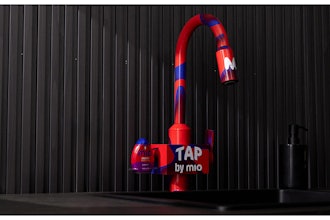Computer-aided Design (CAD) and Computer-aided Manufacturing (CAM) has been in use, in one form or another since the 1960s. Its advent moved engineering and manufacturing departments from paper based drawing and calculations to computer-based processes—reducing the hours required to get products out of engineering and into production on the manufacturing floor. While CAD/CAM can still be useful, other technologies have dethroned it as a top priority. Now, what is old is new again, as new manufacturing technologies, namely Additive Manufacturing, have taken center stage, and elevated the importance of this faithful technology.
Additive manufacturing is emerging as a disruptive factor as organizations discover the boundless opportunities it has to offer—from new ways to design parts, to lowering the cost of spare parts. Although most use cases are at the prototype stage, soon enough organizations will learn how to scale parts for new products to mass production, as well as create new business models to support the spare parts market for products that have already been operating in the field for some time.
The Opportunity
Using models built through CAD, and then employing Additive Manufacturing techniques, can produce anything from simple to complex objects in a range of materials, such as plastic, ceramic, and metal. Today most of the use cases are for prototyping components, which significantly reduces design costs, by uncovering issues earlier. It also saves money by reducing waste and eliminating the need for expensive tools and molds.
According to research firm Oliver Wyman, the forecast for Additive Manufacturing could represent a $400B market by 2030. Industry analysts, however, project that within three years fully 80 percent of global 3D printing capacity will be dedicated to making finished products. GE, for example, expects to print 40,000 jet-fuel nozzles for aircraft by 2020.
CAD/CAM Within the Four Walls of Additive Manufacturing
From a PLM perspective, Additive Manufacturing should not be considered any different than traditional Computer Numerical Control (CNC) enabled manufacturing. The manufacturing process must be planned and documented, based on part size, geometry and material requirements generated. From that, an engineering BOM is created. Once this process is complete, it is transferred to manufacturing to create their version of the BOM, and the Material Process Plan is developed to execute on the manufacturing process.
Design data is used to create the manufacturing outputs, which are then processed for a particular machine—in this case a 3D printer. Prior to printing, job-specific data must be captured. All of this data must be managed and connected for it to be used effectively within the four walls of manufacturing.
To Be Successful—Silos and Walls Must Come Down
In fast-paced manufacturing environments, keeping up with the rate of change between disciplines is a daunting task. The current solution to this is ad hoc meetings and spreadsheets to implement change manually. However, this creates the risk of some critical changes falling through the cracks, leading to quality defects, and potentially costing millions of dollars to address.
Nowhere is this more prevalent than the handover of a Bill of Materials (BOM) between Engineering and Manufacturing. Typically, each department is using legacy systems to manage their version of the BOM. Engineering turns over an approved version of the BOM to Manufacturing so that they can get started planning the manufacturing process. Then updates and changes on the BOM are sent by Engineering and are reflected in a new version of the BOM for Manufacturing. However, as these changes are implemented, manufacturing work already in process has moved on to the next step and the changes have not been implemented. Without visibility into the impact of change to all products in the manufacturing process, the probability of quality issues increases significantly.
Managing and understanding the impact of change across the lifecycle is a significant value proposition for pursuing the Digital Thread. It increases visibility into what is happening between disciplines, enabling collaboration, and reducing quality defects impacting your bottom line and customer perceptions of your products.
Cad/Cam to Support Spare Parts Replacement in the Field
Equipment experiences constant wear and tear as it operates. To make repairs requires a steady stream of spare parts specific to each make, model, and version. These are often complex parts produced in small series and, in cases where equipment has a long life span, sometimes over decades. This is the wheelhouse for Additive Manufacturing—where the importance of CAD/CAM files can make a comeback.
The technology is ready to print parts on demand, but what is missing is the traceability required to access the right file for the specific configuration of the product in need of a replacement. This requires Digital Thread Traceability and Digital Twin Configuration.
Success Requires Access to Critical Information That Has Been Stored Away for Many Years
The Digital Thread is the capability that allows teams across the enterprise to follow a product’s digital history and all of its related digital assets—from the initial planning and analysis, through design, manufacturing, testing, and on to final sustainment and disposal phases.
As Additive capabilities move out to equipment operating in the field, the ability and willingness of the OEM to share information will be a critical factor in determining whether this ability it to print spare parts in the field, becomes a common practice. OEMs can start by allowing access to information for older equipment with limited spare parts availability. Owners of equipment and other organizations like UPS and Fedex that see new business model opportunities will be willing to invest in the additive equipment if this is the case. Long term, OEMs can look to new business models to package information as a service, at a premium, for those that see value in shrinking the supply chain for critical parts.
Coupling the Digital Thread to the product’s individual Digital Twin Configuration allows you the accuracy you need to manufacturer the right part on-demand. A fledging effort to use scanning technologies to replicate parts design is emerging as well, but in reality, this won’t provide the detail around such things as tolerances or face finishes. These will only be available by creating a Digital Thread back to critical information from CAD/CAM residing in and OEM’s engineering and manufacturing applications.
Digital Thread Requires an Open, Platform-Based Approach
A platform approach connects all users and their information in a single environment and enables the creation of Digital Thread Traceability of information related to every individual Digital Twin Configuration of any product ever created. This connectivity enables innovation, resulting in improvements in the products created as well as the supporting processes.
Furthermore, the platform needs to connect information across the enterprise, to support all users across all functions and disciplines. The platform provides a comprehensive set of heterogeneous process-enabling capabilities including platform-native applications which can be packaged and configured to establish and support standardized end-to-end business processes and related data access.
Recap and Recommendations
- As learning and experience continue to push boundaries of what is possible, growth and use cases of Additive Manufacturing are increasing daily. Understanding how this increases the need for accessing critical information = using the Digital Thread is key for success.
- CAD/CAM files locked away for decades will take center stage in the spare parts market for small lot, one off part reproduction to support assets 10 to 40+ years old.
- Although Additive Manufacturing employs new technology, many of the product lifecycle best practices engineering and manufacturing strive for will still be in play, and if done right, will accelerate Additive Manufacturing opportunities.
- Resolving legacy issues within your product lifecycle that historically have plagued manufacturers—such as siloed departments—opens doors for faster time to market and improved quality of products.
- Utilize a platform as the foundational element to build a sustainable Digital Thread. This enables access to critical CAD/CAM information across the lifecycle to support additive manufacturing within the four walls of manufacturing or to support spare parts production in the field.
Jason Kasper is a product marketing manager at Aras Corporation.























